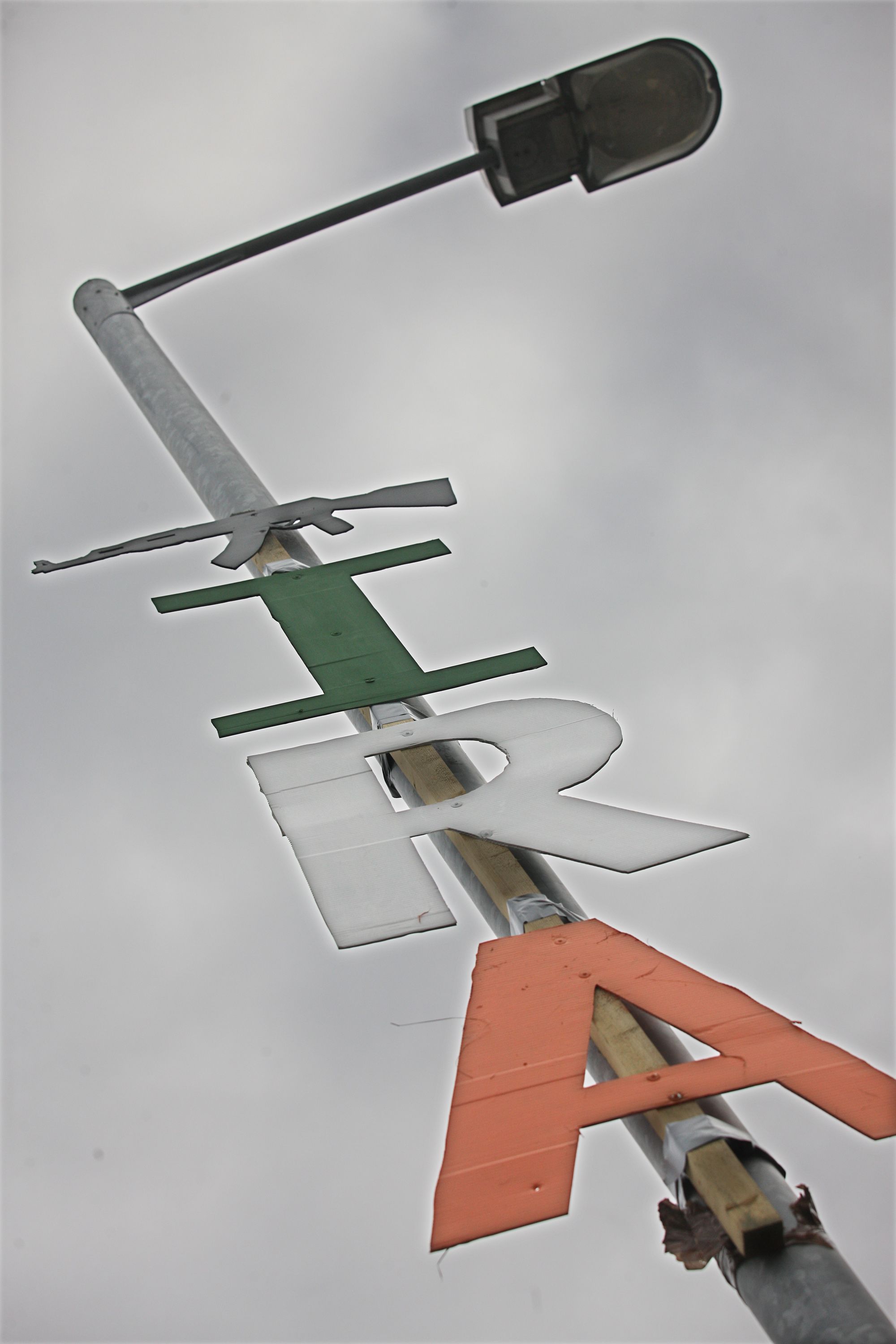UNIONISTS are more likely than nationalists to believe that paramilitaries have a controlling influence in their respective communities, a new report has found. The report also found that fewer people in West Belfast believe that paramilitaries have an influence in their area compared to their counterparts living in Ardoyne and the New Lodge.
The Mitchel Institute at Queen's University Belfast, supported by Co-operation Ireland, undertook research in each Communities in Transition (CIT) area last year. The project focuses on areas with a history of paramilitary activity.
The authors of the report state that when respondents in nationalist and republican areas were questioned about paramilitaries the term was often contested. Participants often answered: "We don’t have paramilitaries, we just have organised crime gangs."
In Belfast the areas surveyed were West Belfast, Ardoyne, New Lodge, East Belfast and Shankill. Other areas featured were Carrickfergus, Derry, Larne, Lurgan and North Down.
While many of the findings were similar in all the areas, attitudes also differed significantly in the various Communities in Transition that were surveyed.
In West Belfast the survey found that:
62% of those surveyed agreed or strongly agreed that there was a strong sense of community throughout West Belfast. The average response across all the CIT sites was 66%.
72% agreed or strongly agreed that they felt connected to their local area. The average response across all the CIT sites was 68%. 6% of participants indicated they were involved with a Local Church. 11% were associated with a Sports Club. 5% were involved in a Local School. 1% participated in Neighbourhood Associations.
65% of respondents indicated that they would know who to contact if they had a problem associated with their community. The average response across all the CIT sites was 84%.
30% agreed or strongly agreed that they had the skills to help change their area for the better. The average response across all the CIT sites was 50%.
The Falls Road
17% of respondents felt the area would be in better condition in five years time. The average response across all the CIT sites was 29%.
34% of respondents agreed or strongly agreed that they had an influence over decisions that are made about their area. The average response across all the CIT sites was 27%.
83% of participants indicated that in five years time, the area would be either in the same condition or worse. The average response across all the CIT sites was 71%.
38% of respondents felt that local residents abided by the rule of law. The average response across all the CIT sites was 61%.
36% felt that improved lighting and alleygating would make them feel safer, while 30% said improved relationships with the PSNI would also help. The average response across all the CIT sites was 60% & 59%.
66% felt anti-social behaviour was a problem in the area. The average response across all the CIT sites was 55%.
78% believed that drug related crime was also a problem in the area. The average response across all the CIT sites was 57%.
18% of respondents felt that young people living throughout West Belfast were under too much influence from paramilitary groups. The average response across all the CIT sites was 32%.
20% felt that paramilitary groups create fear and intimidation in the area. The average response across all the CIT sites was 34%.
15% felt that paramilitary groups had a controlling influence in their area. The average response across all the CIT sites was 27%.
In Ardoyne (which also included unionist Glenbryn) the report found that:
67% of those surveyed agreed or strongly agreed that there was a strong sense of community throughout Ardoyne. On average, across all the other CIT sites, 66% agreed or strongly agreed that there was a strong sense of community throughout their respective area.
74% agreed or strongly agreed that they felt connected to their local area. The average response across all the other CIT sites was 68%.
27% of participants indicated they were involved with a Local Church. 18% were associated with a Sports Club. 16% were involved in a Local School. 8% participated in Neighbourhood Associations.
82% of respondents indicated that they would know who to contact if they had a problem associated with their community. The average across all the CIT sites was 84%
67% agreed or strongly agreed that they had the skills to help change their area for the better. The average across all the CIT sites was 50%.
37% of respondents felt the area would be in better condition in five years time. The average across all the CIT sites was 29%.
Only 15% of respondents agreed or strongly agreed that they had an influence over decisions that are made about their area. The average across all the CIT sites was 27%.
63% of participants indicated that in five years time, the area would be either in the same condition or worse. The average across the CIT sites was 71%.
Ardoyne
67% of respondents felt that local residents abided by the rule of law. The average across all the CIT sites was 61%.
76% felt that improved lighting and alleygating would make them feel safer, while 55% said improved relationships with the PSNI would also help. The average across all the CIT sites was 60% & 59%.
72% felt anti-social behaviour was a problem in the area. The average across all the CIT sites was 55%.
76% believed that drug related crime was also a problem in the area. The average across all the CIT sites was 57%.
24% of respondents felt that young people living throughout Ardoyne were under too much influence from paramilitary groups. The average across all the CIT areas was 32%.
40% felt that paramilitary groups create fear and intimidation in the area. The average across all the CIT areas was 34%.
26% felt that paramilitary groups had a controlling influence in their area.
In the New Lodge the report found that:
67% of those surveyed agreed or strongly agreed that there was a strong sense of community throughout New Lodge. The average response across all the CIT sties was 66%.
66% agreed or strongly agreed that they felt connected to their local area. The average response across all the CIT sites was 68%.
22% of participants indicated they were involved with a Local Church. 15% were associated with a Sports Club. 12% were involved in a Local School. 2% participated in Neighbourhood Associations.
90% of respondents indicated that they would know who to contact if they had a problem associated with their community. The average response across all the CIT sites was 84%.
70% agreed or strongly agreed that they had the skills to help change their area for the better. The average response across all the CIT sites was 50%.
32% of respondents felt the area would be in better condition in five years time. The average response across all the CIT sites was 29%.
Only 11% of respondents agreed or strongly agreed that they had an influence over decisions that are made about their area. The average response across all the CIT sites was 27%.
68% of participants indicated that in five years time, the area would be either in the same condition or worse. The average response across all the CIT sites was 71%.
67% of respondents felt that local residents abided by the rule of law. The average response across all the CIT sites was 61%.
The New Lodge
76% felt that improved lighting and alley-gating would make them feel safer, while 55% said improved relationships with the PSNI would also help. The average response across all the CIT sites was 60% & 59%
72% felt anti-social behaviour was a problem in the area. The average response across all the CIT sites was 55%.
76% believed that drug related crime was also a problem in the area. The average response across all the CIT sites was 57%.
24% of respondents felt that young people living throughout the New Lodge were under too much influence from paramilitary groups. The average response across all the CIT sites was 32%.
34% felt that paramilitary groups contribute to crime, drug dealing and ASB in the area. The average response across all the CIT sites was 34%.
40% felt that paramilitary groups create fear and intimidation in the area. The average response across all the CIT sites was 27%.
26% felt that paramilitary groups had a controlling influence in their area.
The figures for perceived paramilitary influence in unionist areas of Belfast was higher than in nationalist areas.
In East Belfast the report found:
50% of respondents felt that young people living throughout East Belfast were under too much influence from paramilitary groups. The average response across all the CIT sites was 32%
57% felt that paramilitary groups contribute to crime, drug dealing and ASB in the area. The average response across all the CIT sites was 34%
49% felt that paramilitary groups create fear and intimidation in the area. The average response across all the CIT sites was 27%
45% felt that paramilitary groups had a controlling influence in their area.
In the Shankill the report found:
51% of respondents felt that young people living throughout the Shankill were under too much influence from paramilitary groups. The average response across all the CIT sites was 32%.
46% felt that paramilitary groups create fear and intimidation in the area. The average response across all the CIT sites was 34%.
46% felt that paramilitary groups had a controlling influence in their area. The average response across all the CIT sites was 27%.








